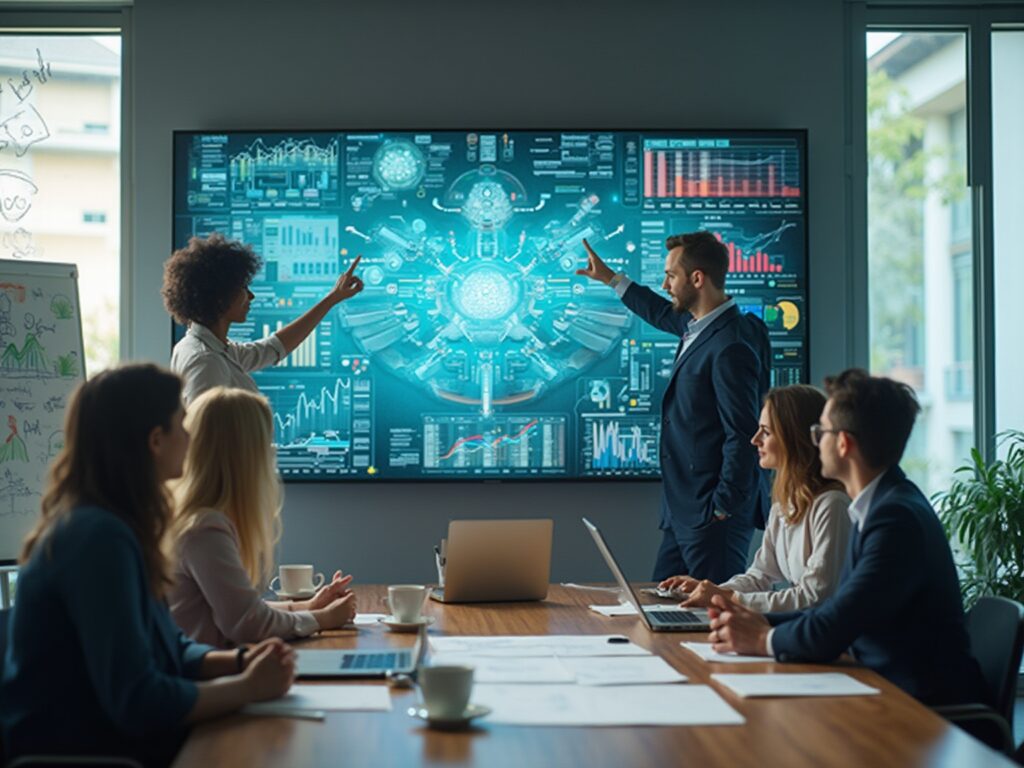Overview
Data analytics that identifies root causes is classified as diagnostic analytics. This branch focuses on elucidating why specific events occurred by analyzing historical data and revealing underlying patterns. Techniques such as data mining and regression analysis are pivotal in this process, allowing organizations to pinpoint the issues at hand. By leveraging these insights, businesses can make informed decisions that significantly enhance operational efficiency.
How effectively is your organization utilizing diagnostic analytics to address its challenges?
Introduction
In a world where data reigns supreme, the ability to decipher its complexities can mean the difference between stagnation and success for organizations. Data analytics, especially diagnostic analytics, emerges as a crucial tool for identifying the root causes behind operational challenges. By transforming raw data into actionable insights, businesses can enhance decision-making and drive efficiency across various sectors.
This article delves into the multifaceted realm of diagnostic analytics, exploring its methodologies, real-world applications, and the transformative impact it has on industries ranging from healthcare to finance. As organizations navigate the intricacies of data, understanding and leveraging these analytical techniques becomes vital for sustained growth and innovation.
Understanding Data Analytics: The Key to Root Cause Identification
Data analytics entails the systematic computational analysis of information, aimed at uncovering patterns, correlations, and actionable insights. This discipline is crucial for identifying root causes of operational challenges by transforming raw inputs into meaningful information that drives informed decision-making. By leveraging various analytical techniques, organizations can effectively diagnose issues, leading to enhanced operational efficiency.
Understanding the four primary types of data analytics is essential for organizations striving to refine their processes:
- Descriptive Analytics: This type focuses on summarizing historical data to understand what has happened in the past, providing a foundation for further analysis by highlighting trends and patterns.
- Diagnostic Analytics: Building on descriptive analytics, this method seeks to explain why certain events occurred. It employs techniques such as information mining and correlation analysis to identify relationships and root causes.
- Predictive Analytics: This forward-looking approach uses statistical models and machine learning techniques to forecast future outcomes based on historical data, enabling organizations to anticipate potential issues before they arise.
- Prescriptive Analysis: The most advanced form, prescriptive analysis suggests actions to achieve desired outcomes. It merges insights from predictive analysis with optimization techniques to guide decision-making.
Recent statistics reveal that only 33% of information leaders actively monitor their teams’ return on investment (ROI) from information analysis initiatives. Additionally, 23% track operational KPIs, and 10% utilize quantitative and qualitative success metrics, indicating a significant opportunity for improvement in measuring the effectiveness of these efforts. Moreover, 29% of information leaders are still in the initial phases of ROI evaluation, while another 29% depend on anecdotal proof, underscoring the challenges entities face in efficiently evaluating the impact of information analysis.
Successful implementations of analytics, particularly through Robotic Process Automation (RPA) solutions like EMMA RPA and Microsoft Power Automate, have demonstrated substantial impacts on operational efficiency. EMMA RPA automates repetitive tasks, alleviating task repetition fatigue, while Microsoft Power Automate streamlines workflows, addressing staffing shortages. These tools boost employee morale and enable companies to concentrate on strategic initiatives.
For instance, organizations that automate manual processes and employ machine learning for intricate information processing have reported considerable time savings and enhanced ROI. As Jonathan Wagstaff, Director of Market Intelligence at DCC Technology, noted, the automation of complex information tasks has liberated valuable resources, enabling teams to focus on strategic initiatives.
By 2025, the significance of information assessment in operational effectiveness continues to expand, with organizations increasingly recognizing its role in enhancing decision-making processes. Current trends emphasize the need for comprehensive analytics strategies, particularly in identifying root causes, while also driving continuous improvement across operations. A case study titled “Tracking ROI in Analytics” illustrates the challenges faced by leaders in measuring ROI, further underscoring the necessity for robust analytical frameworks.
By adopting these analytical methods alongside RPA solutions, businesses can transform their information into a powerful asset for informed decision-making and operational excellence.
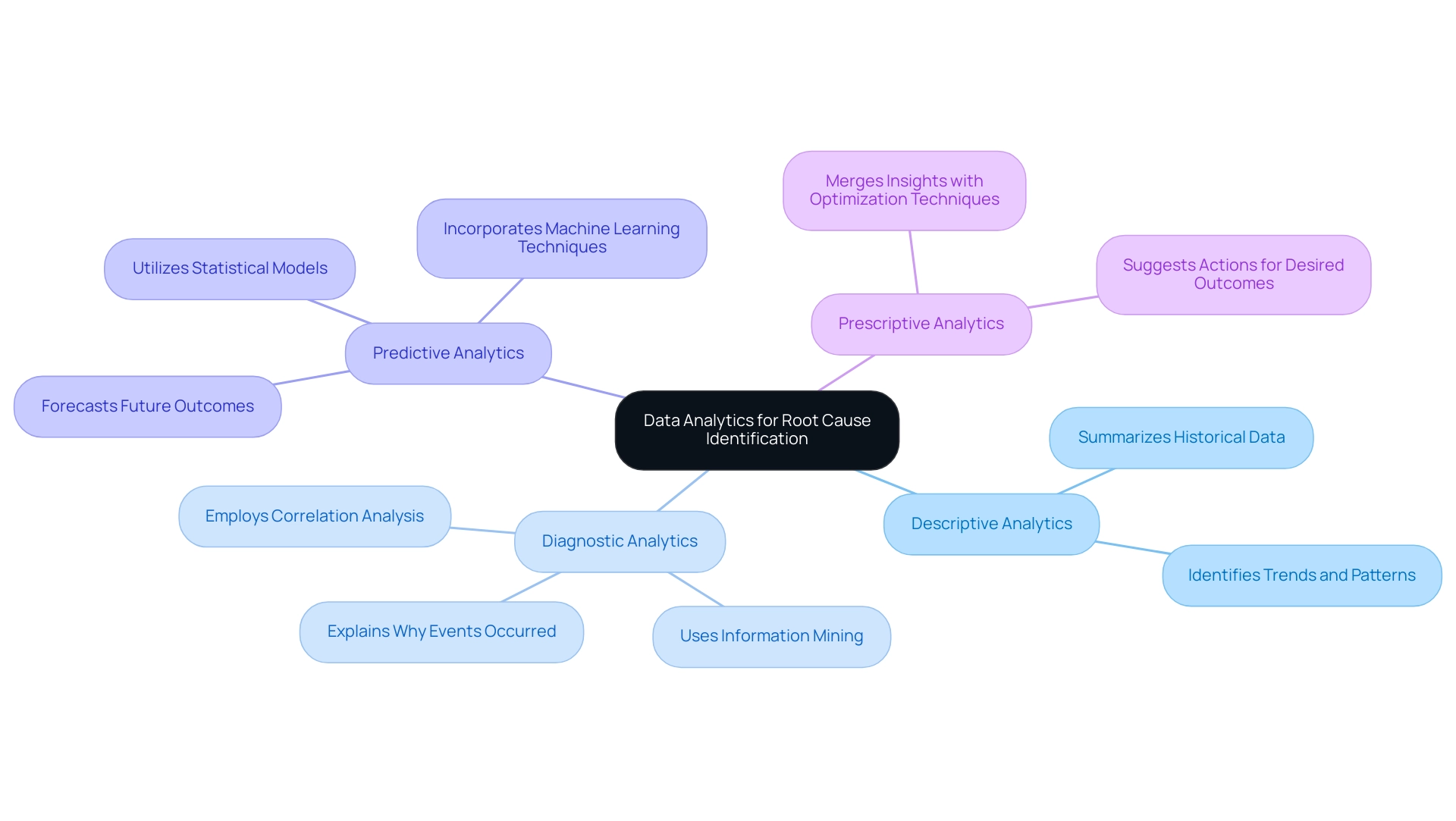
Diagnostic Analytics: The Core of Root Cause Analysis
Diagnostic analysis stands as a pivotal subset of information examination, employing data to pinpoint root causes within various situations. This form of data analytics is dedicated to uncovering the reasons behind specific events or outcomes by addressing critical questions such as ‘Why did this happen?’ It leverages historical information to identify patterns, correlations, and anomalies that inform decision-making.
Essential methods in analytical diagnosis encompass information mining, correlation examination, and regression analysis—each playing a vital role in uncovering insights that drive operational enhancements.
In 2025, the prevalence of diagnostic analysis continues to rise across diverse industries, with organizations increasingly recognizing its value in boosting performance and efficiency. AI-driven assessment tools, such as ThoughtSpot, now swiftly reveal irregularities and insights, significantly enhancing information utilization. Additionally, Creatum GmbH’s tailored AI solutions, including Small Language Models and GenAI Workshops, empower businesses to improve data quality and optimize their processes.
Statistics indicate that analytical assessments assist organizations in efficiently identifying elements influencing specific results, thereby enhancing overall business performance.
Practical applications of analytical evaluation underscore its effectiveness, particularly in understanding root causes within various contexts. A notable case study illustrates the customization of chronic illness management, utilizing assessment methods to evaluate patient data and develop personalized care strategies. For instance, if data reveals that patients frequently experience blood sugar spikes despite following prescribed diets, healthcare providers can adjust dietary recommendations or insulin dosages, ultimately leading to improved patient outcomes.
This case exemplifies the broader impact of analytical assessment on operational enhancements across multiple sectors.
Moreover, current trends highlight the growing complexity of assessment methods. Organizations are adopting advanced algorithms and software programs to identify root causes of problems, streamlining their operations further. The integration of Robotic Process Automation (RPA) enhances operational efficiency by automating manual workflows, allowing teams to concentrate on strategic initiatives.
Expert insights affirm that regression analysis, as noted by Jan Hammond, a Professor at Harvard Business School, “allows us to gain insights into the structure of that relationship and provides measures of how well the data fit that relationship,” thereby enhancing the reliability of findings.
As analytical assessment evolves, understanding root causes becomes increasingly essential, enabling entities to implement targeted interventions that foster growth and innovation. Furthermore, diagnostic analytics can identify technology issues through software programs or algorithms that run tests to determine the root cause of problems, illustrating its practical applications in today’s data-rich environment. Client testimonials from organizations leveraging Creatum GmbH’s technology solutions underscore the transformative impact of these tools on enhancing operational efficiency and driving business growth.
Significantly, feedback from clients highlights the effectiveness of Creatum’s Power BI services, including the 3-Day Power BI Sprint, in delivering actionable insights and enhancing reporting capabilities.
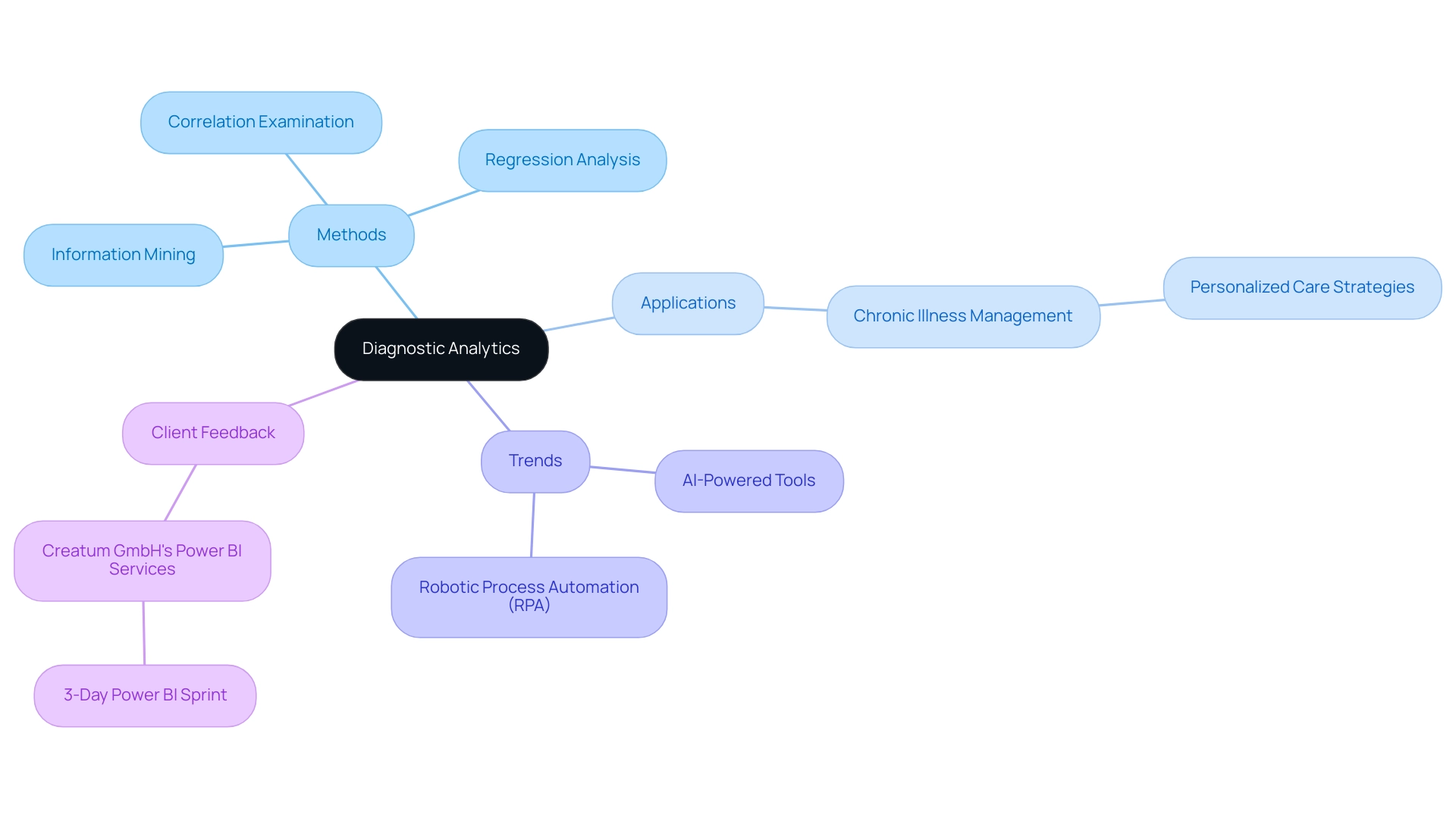
How Diagnostic Analytics Works: Techniques and Methodologies
Diagnostic analytics, a critical type of data analytics, utilizes data to identify root causes in various situations. It employs a variety of techniques to examine information and uncover underlying issues, each contributing uniquely to the understanding of these complexities. Key methodologies include:
-
Data Mining: This technique involves exploring extensive datasets to identify patterns and relationships that may not be immediately apparent. There are two primary types of mining: predictive mining, which helps determine outcomes, and descriptive mining, which informs users of outcomes. For instance, in fraud detection, information mining can uncover unexpected transaction patterns, enabling organizations to investigate potential mismanagement of funds and mitigate risks effectively. RPA can streamline the mining process by automating collection and analysis, allowing teams to focus on interpreting results rather than manual handling. Leveraging Business Intelligence tools can further enhance this process, transforming raw information into actionable insights that drive growth and innovation.
-
Regression Analysis: A cornerstone of statistical analysis, regression analysis assesses the strength and nature of relationships between variables. Current success rates indicate that businesses leveraging regression analysis can significantly enhance their predictive capabilities, leading to more informed decision-making. RPA can automate the preparation and analysis phases, reducing the time spent on manual tasks and enhancing accuracy. Expert opinions indicate that regression analysis is essential for comprehending intricate connections in information, particularly when paired with customized AI solutions that cut through the noise of overwhelming options in the AI landscape.
-
Correlation Analysis: This method evaluates the degree to which two variables move in relation to each other, providing insights into potential dependencies that can inform strategic adjustments. By integrating RPA, companies can automate the collection and analysis of these correlations, enhancing operational efficiency and freeing up resources for more strategic initiatives.
-
Anomaly Detection: This technique focuses on identifying outliers in information that may signal significant issues. By detecting anomalies, entities can pinpoint areas requiring immediate attention, thus facilitating timely interventions. The integration of RPA can streamline this process, allowing teams to focus on strategic, value-adding work rather than manual, repetitive tasks.
The integration of these methodologies enables organizations to systematically examine information, revealing insights that drive decision-making and process enhancements. For instance, the effectiveness of information mining techniques in uncovering patterns has been statistically validated, showcasing their role in enhancing operational efficiency. Moreover, as observed by Julie Bang, “Information mining employs algorithms and various other techniques to transform large collections of information into useful output.”
Additionally, the challenges in finding professionals with the necessary expertise in data mining techniques highlight the importance of investing in training or collaborating with external experts to bridge the skill gap. This ensures that organizations can fully leverage these powerful tools for effective root cause analysis.
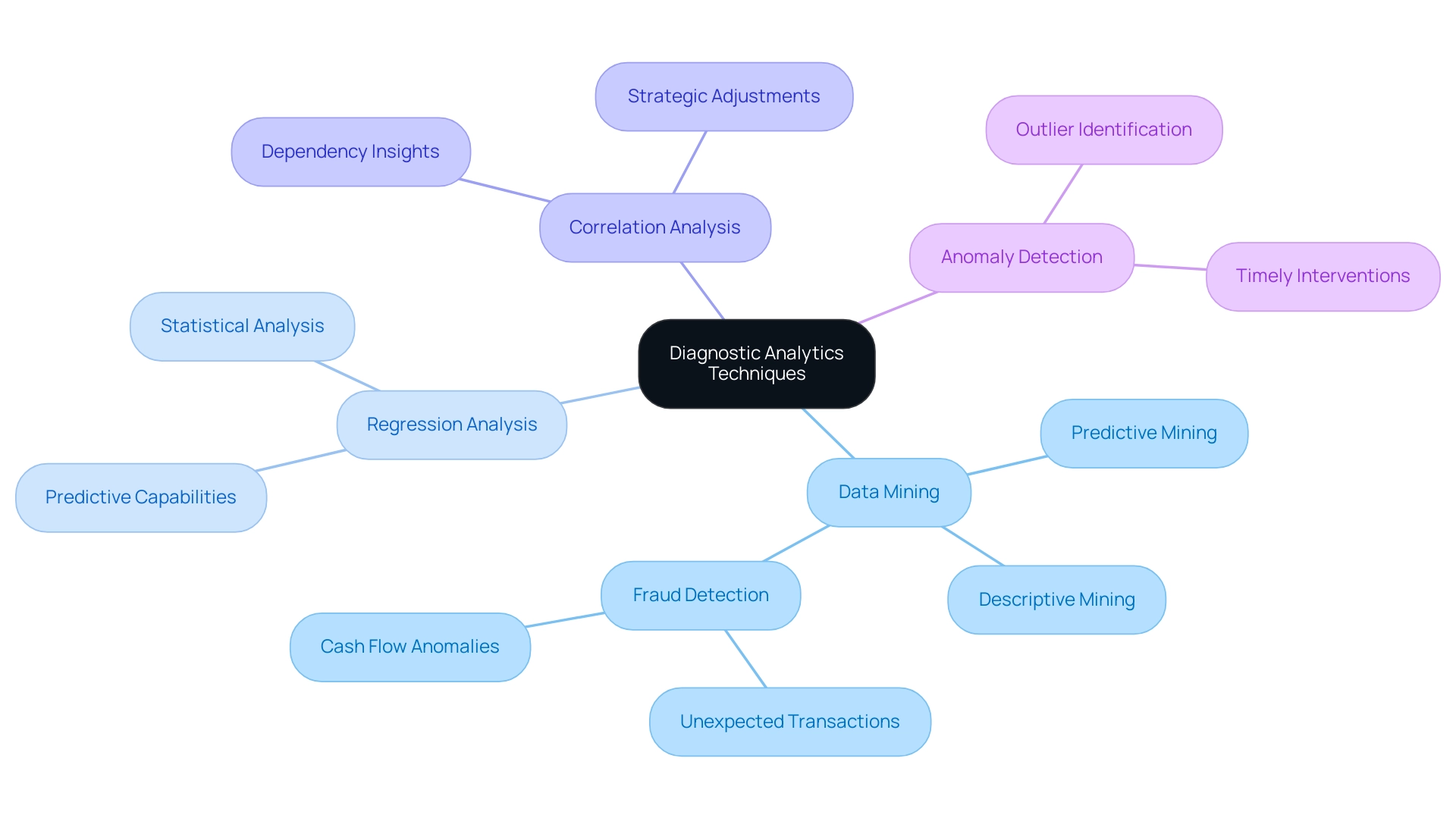
Applications of Diagnostic Analytics Across Different Industries
Diagnostic analysis plays a pivotal role in enhancing operational efficiency across various industries by utilizing data analytics to identify root causes in specific situations, addressing challenges effectively. For example:
-
Healthcare: Hospitals are increasingly leveraging diagnostic analytics to reduce readmission rates. By pinpointing the underlying factors contributing to patient returns, healthcare providers can implement targeted interventions, ultimately improving patient outcomes and reducing costs. A notable case study is the implementation of GUI automation in a mid-sized healthcare company, which automated information entry and software testing. This resulted in a 70% decrease in entry mistakes and a 50% increase in testing procedures, significantly enhancing operational efficiency. The return on investment from these improvements was realized within just six months, demonstrating the transformative impact of automation on healthcare service delivery. Key features of Creatum GmbH’s GUI automation solutions, such as EMMA RPA and Power Automate, played a crucial role in these outcomes by streamlining processes and enhancing information accuracy.
-
Manufacturing: In the manufacturing sector, companies utilize analytical tools to examine production data, uncovering the underlying reasons for delays and quality issues. This data-driven approach leads to streamlined processes and improved product quality, fostering greater operational efficiency. The pharmaceutical sector, in particular, is projected to experience double-digit growth rates in data analysis through 2030, underscoring the significance of these tools in driving industry expansion.
-
Retail: Retailers employ analytical tools to gain insights into customer behavior, allowing them to optimize inventory management based on real-time sales trends. This not only improves stock levels but also enhances customer satisfaction by ensuring product availability.
-
Finance: Financial institutions utilize analytical techniques to detect fraudulent activities by examining transaction patterns. This proactive approach mitigates risks and strengthens trust with customers by ensuring the integrity of financial operations. Creatum GmbH addresses ethical considerations regarding data use and potential bias in fraud detection, emphasizing the necessity for responsible data analysis practices.
These applications underscore the crucial role of diagnostic analysis in enhancing efficiency and innovation across sectors. As companies continue to embrace these analytical tools, the potential for improved operational outcomes becomes increasingly evident. As Sarah Lee noted, “pharmaceutical companies utilizing data analysis for clinical trial enhancement have lowered development expenses by 15-25%,” further illustrating the tangible advantages of evaluative statistics.
Additionally, client testimonials from leaders in the healthcare sector highlight how Creatum GmbH’s GUI automation solutions have revolutionized their operational workflows, driving significant improvements in efficiency and productivity.
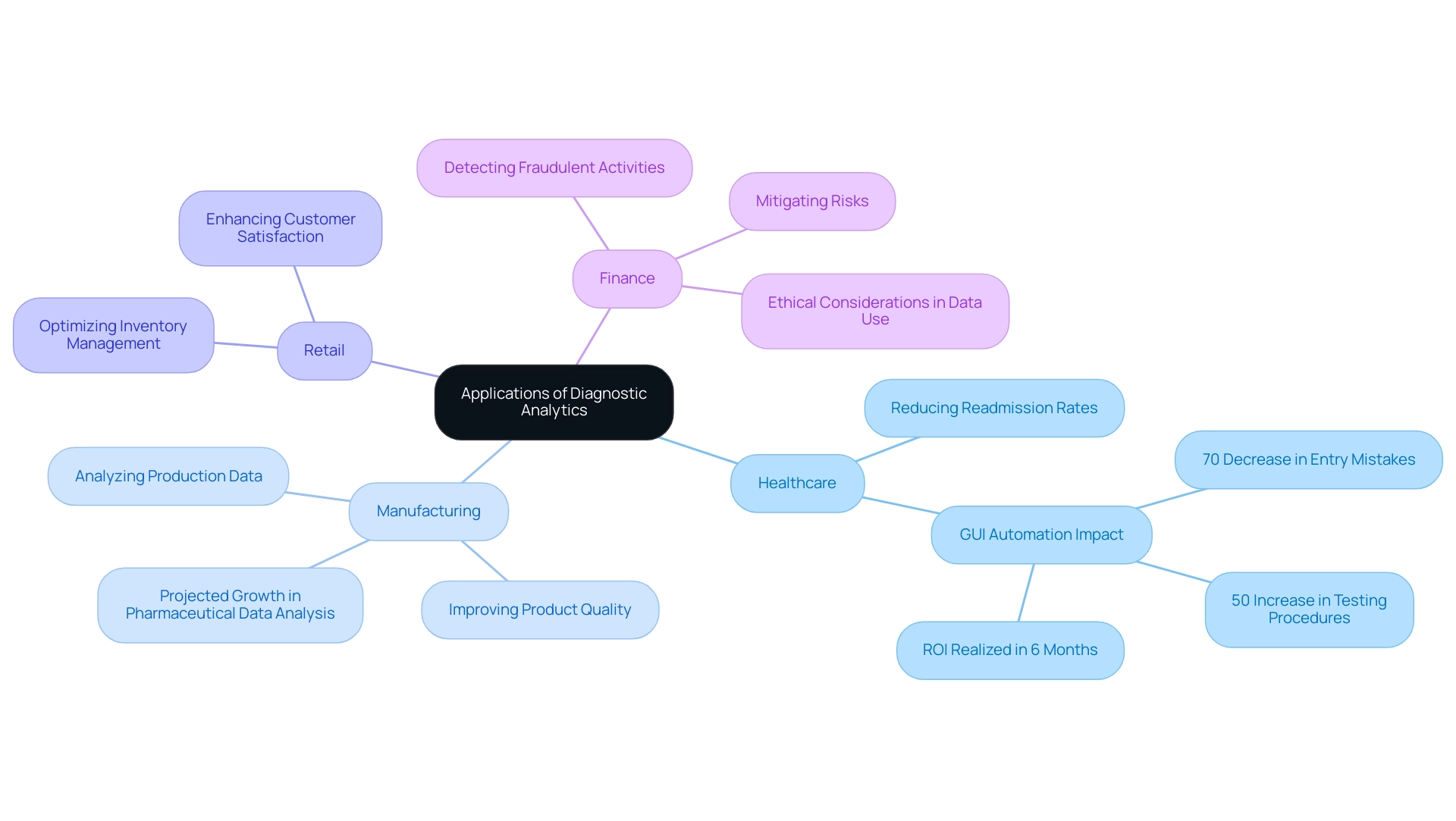
Benefits and Challenges of Using Diagnostic Analytics
Utilizing analytical assessments presents numerous benefits that can significantly enhance institutional performance:
-
Enhanced Decision-Making: By uncovering the root causes of problems, these assessments empower institutions to make data-informed choices that lead to improved outcomes. This capability is essential in today’s data-rich environment, where informed decisions can set successful businesses apart from their competitors. For example, hypothesis testing serves as a statistical method that aids in validating or refuting assumptions, underscoring the importance of data-driven decision-making. Moreover, Business Intelligence tools can further elevate this process by transforming raw data into actionable insights, enabling organizations to respond promptly to market shifts.
-
Improved Operational Efficiency: Identifying inefficiencies allows organizations to implement targeted improvements that minimize waste and enhance productivity. In this context, Robotic Process Automation (RPA) plays a crucial role by automating manual workflows, enabling teams to concentrate on strategic initiatives. A notable instance comes from Christopher Vardanyan, co-founder at Rocket Moving Services, who noted that diagnostic analytics—an approach that leverages data to identify root causes—has been instrumental in refining their local moving services. By analyzing customer feedback and operational data, they discovered that using larger trucks could accommodate more items per trip, reducing the need for multiple journeys. This adjustment resulted in shorter moving times and lower fuel and labor costs, culminating in an 18% increase in customer satisfaction due to expedited service and reduced expenses. Additionally, a case study on GUI automation in a mid-sized firm demonstrated that automating data entry and software testing led to a 70% reduction in errors and an 80% enhancement in workflow efficiency, emphasizing the tangible benefits of integrating RPA into operations.
-
Cost Savings: Addressing issues at their source enables organizations to avoid costly mistakes and optimize resource allocation. The financial benefits of assessment analysis can be substantial, as entities that effectively implement these strategies often experience significant reductions in operational costs. By leveraging tailored AI solutions alongside RPA, businesses can further refine their operational frameworks, ensuring resources are allocated both efficiently and effectively.
Despite these advantages, organizations face several challenges when implementing analytical evaluations:
-
Information Quality: The accuracy of insights derived from analytical processes heavily relies on the quality of the underlying data. Poor data quality can lead to erroneous conclusions, making robust information management practices imperative. A case study on the role of artificial intelligence in analysis highlights that while AI enhances analytical capabilities, it also introduces challenges related to integration and data quality.
-
Complexity of Implementation: Integrating analytical evaluation into existing systems can be a complex and resource-intensive endeavor. Organizations may need to invest in specialized skills or collaborate with technology vendors to ensure successful implementation. This need for specialized expertise is a critical consideration for companies navigating the intricacies of evaluative analysis.
-
Resistance to Change: Employees may resist adopting new processes or technologies, necessitating effective change management strategies to facilitate a seamless transition.
Understanding these factors is crucial for firms aiming to leverage evaluative analysis effectively. As the landscape of data examination continues to evolve, the ability to manage these challenges will determine the success of entities in harnessing the full potential of their data. Creatum GmbH is dedicated to assisting businesses in overcoming these hurdles through customized AI solutions and RPA, ensuring they can achieve operational excellence.
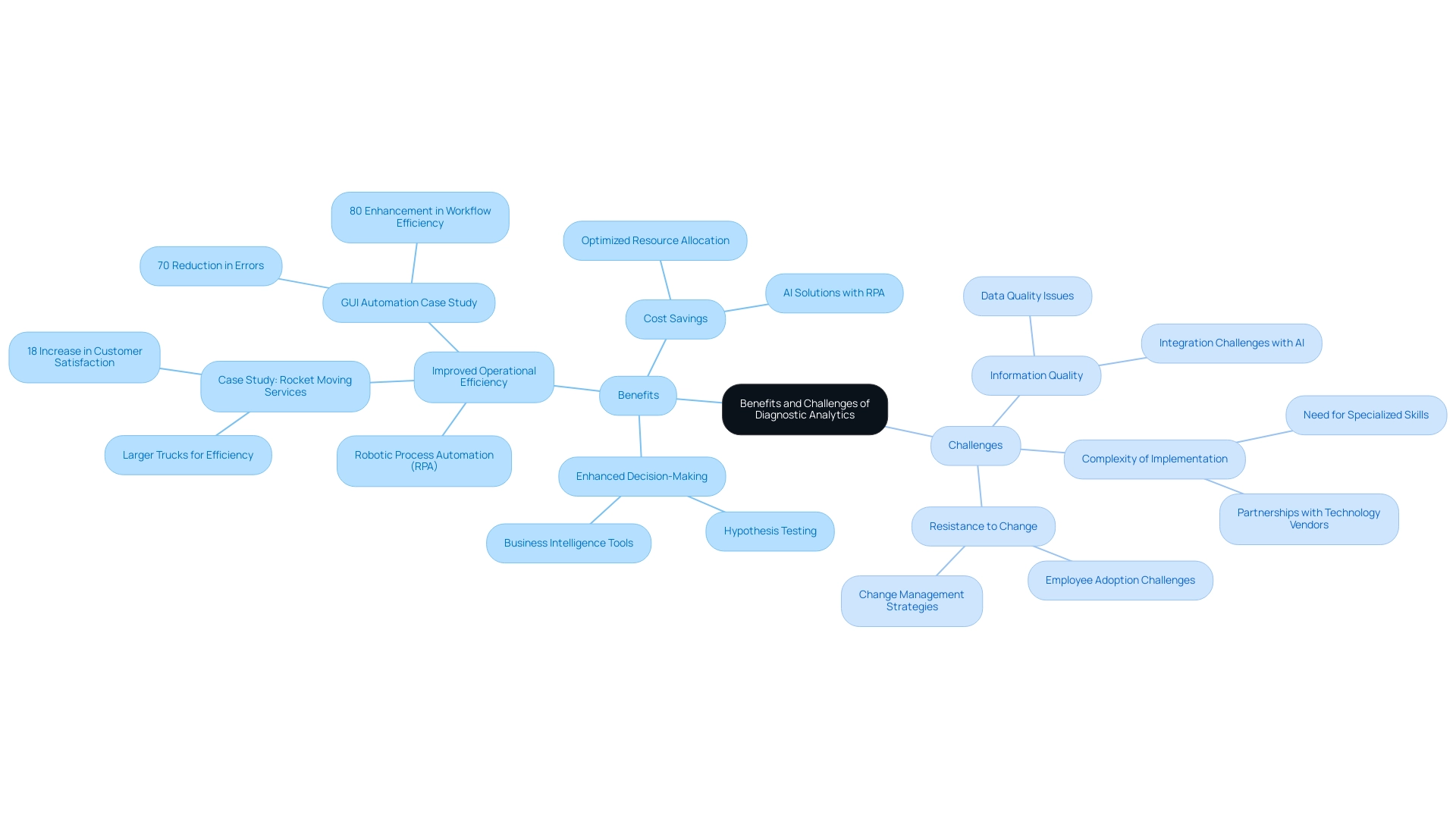
Case Studies: Real-World Examples of Diagnostic Analytics in Action
Numerous organizations have effectively utilized analytical techniques to address specific operational challenges:
-
Case Study 1: A Major Retailer: Confronted with declining sales, this retailer employed analytical methods to scrutinize customer purchasing behaviors. The analysis revealed that a recent website redesign had adversely affected user experience. By reverting to the previous design, the retailer experienced a remarkable 20% increase in sales within just one month. In parallel, a healthcare provider leveraged diagnostic analytics—data analytics that identifies root causes—to uncover the underlying causes of elevated readmission rates. A thorough examination of patient information revealed that insufficient discharge instructions were a critical issue. By implementing a revised discharge protocol, the hospital successfully reduced readmission rates by 15%, significantly improving patient outcomes. This case exemplifies the importance of effective collaboration between healthcare professionals and data scientists, as highlighted by Harvard Business Review, to leverage information for enhancing patient welfare.
-
Case Study 3: Streamlining Operations with GUI Automation: A mid-sized healthcare company faced challenges with manual entry errors, slow software testing, and difficulties integrating outdated systems. By implementing GUI automation solutions from Creatum GmbH, they automated information tasks, enhanced software testing, and integrated legacy systems seamlessly. The results were remarkable: input errors decreased by 70%, testing procedures sped up by 50%, and overall workflow effectiveness enhanced by 80%. The return on investment was achieved within six months, showcasing the transformative impact of automation on operational efficiency and software quality in healthcare service delivery. Client testimonials emphasize the efficacy of Creatum’s solutions in promoting these enhancements.
-
Case Study 4: A Manufacturing Firm: This manufacturer encountered issues with production delays and sought analytical assessments to examine workflow information. The insights gained allowed them to identify bottlenecks within their supply chain. By improving inventory management practices, they realized a 30% decrease in lead times, boosting overall operational efficiency.
These case studies highlight the transformative effect of analytical insights and automation across different sectors, illustrating how data analytics can identify root causes and promote substantial enhancements in performance and customer satisfaction. Furthermore, data science can help healthcare organizations optimize staffing levels and reduce wait times, demonstrating the broader benefits of these technologies in operational efficiency.
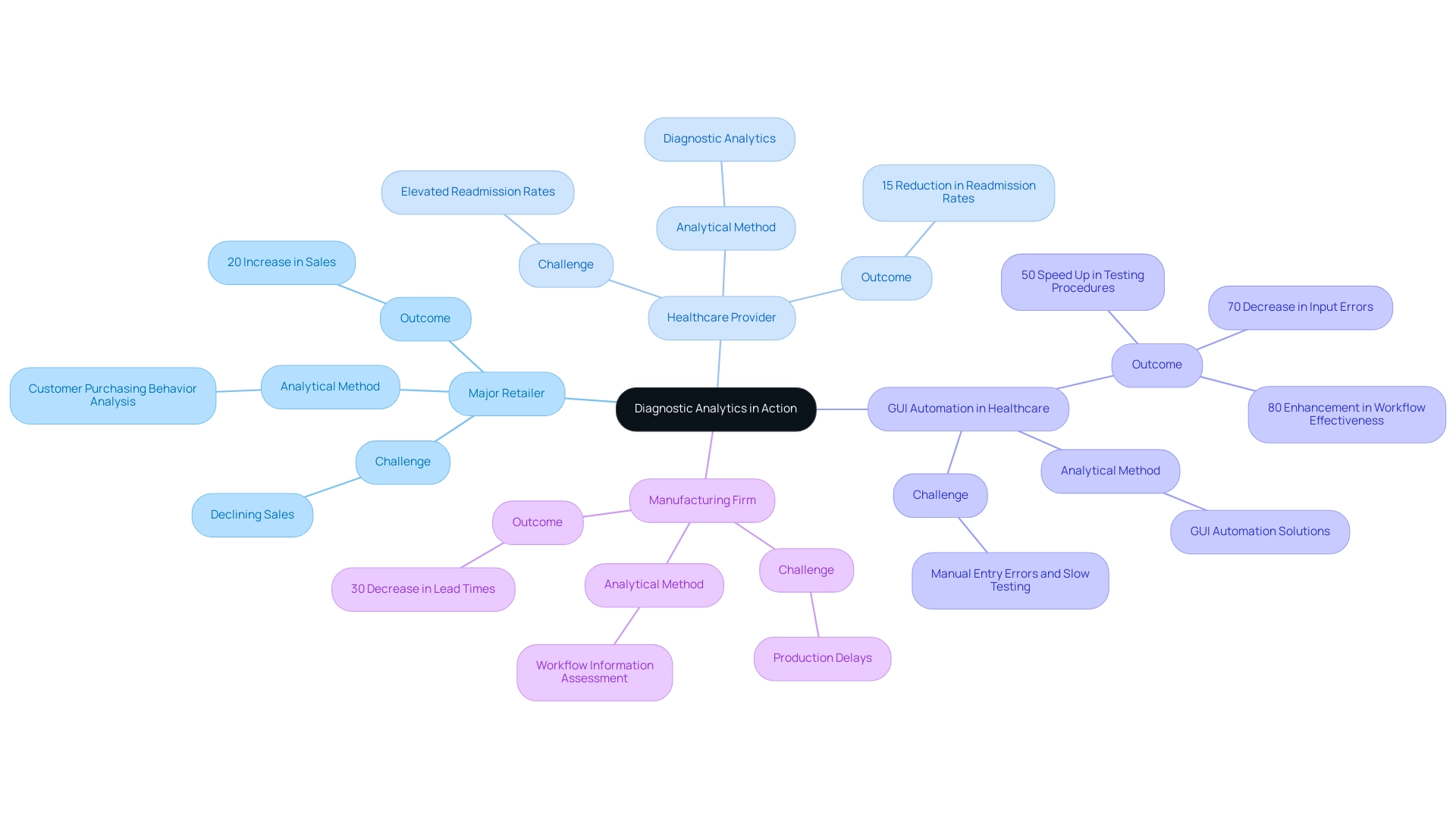
Common Misconceptions and FAQs About Diagnostic Analytics
Common misconceptions about diagnostic analytics include:
-
Myth 1: Diagnostic Analytics is Only for Large Companies: Contrary to this belief, businesses of all sizes can leverage diagnostic analytics to enhance their operations and decision-making processes. Small and medium-sized enterprises (SMEs) are increasingly adopting these tools to gain insights that drive efficiency and growth, especially when combined with Robotic Process Automation (RPA) solutions from Creatum GmbH, which streamline workflows and reduce manual errors.
-
Myth 2: It Requires Complex Algorithms: While advanced analytical techniques can provide deeper insights, many effective assessment methods are straightforward and user-friendly. Organizations can start with basic tools that do not necessitate extensive technical expertise. Creatum’s tailored AI solutions further simplify this process, enabling teams to focus on strategic, value-adding work.
-
Myth 3: Diagnostic Analytics is the Same as Predictive Analytics: This is a common misunderstanding. Diagnostic analysis, which is a type of data analytics that uses data to help identify root causes in a situation, mainly deals with examining previous occurrences to comprehend what transpired and the reasons. In contrast, predictive analysis emphasizes anticipating future results based on historical information. In fact, there are four fundamental types of information analysis: descriptive, predictive, and prescriptive, each serving a unique role in the analysis landscape.
As highlighted by our clients, such as Herr Malte-Nils Hunold from NSB GROUP, the integration of RPA and Business Intelligence tools has significantly enhanced operational efficiency and driven business growth. For example, the transformative effect of Creatum’s Power BI Sprint has enabled entities to expedite analysis and reporting, resulting in informed decision-making.
FAQs:
-
Q: How can I start using diagnostic analytics in my organization?
A: Begin by evaluating your existing data quality and pinpointing key areas where insights are necessary. Implement user-friendly tools that facilitate analysis and invest in training your team on best practices to maximize the effectiveness of these tools. -
Q: What kinds of information are required for effective analytical diagnosis?
A: High-quality historical data that is relevant to the specific issues being analyzed is crucial for deriving accurate insights. Ensuring data integrity and relevance will significantly enhance the results of your assessment efforts. -
Q: Are assessment analysis tools available for small enterprises?
A: Yes, many diagnostic analytics tools are designed to be user-friendly and affordable, making them accessible for businesses of all sizes. This accessibility enables smaller organizations to leverage the potential of information analysis without needing extensive resources.
As William Zhang, an engineer and business strategist, observed, “Using descriptive analysis, they examined previous transaction information and discovered that customers were less likely to purchase their products because of seasonal fluctuations in demand.” This emphasizes how data analysis can guide business decisions. Furthermore, entities encounter obstacles in information analysis, such as guaranteeing information privacy and security, upholding information quality, and tackling the skills gap in information analysis, as detailed in the case study titled ‘Challenges in Information Analysis.’
By addressing these misunderstandings and offering clear direction, organizations can better recognize the importance of analytical evaluation, especially regarding which type of data analytics uses data to help identify root causes in a situation, and its role in enhancing operational effectiveness. Moreover, the distinctive value offering of delivering tailored solutions that improve information quality and streamline AI implementation is essential for efficient evaluation.

The Future of Diagnostic Analytics: Trends and Innovations
The future of assessment analysis is on the brink of significant transformation, primarily fueled by the emergence of new technologies. Key trends influencing this evolution include:
-
Integration of AI and Machine Learning: These advanced technologies are revolutionizing diagnostic assessments by enabling more precise information analysis and predictive insights. As companies increasingly adopt AI—65% are either utilizing or actively exploring these technologies in analytics—they can uncover deeper patterns and correlations within their data, leading to more informed decision-making. Our tailored AI solutions, including Small Language Models and GenAI Workshops, address challenges such as poor master information quality and perceived complexities, enhancing the effectiveness of AI implementation. However, 40% of executives perceive advanced AI technologies as prohibitively expensive, posing a challenge for widespread adoption.
-
Real-Time Analytics: The rising demand for real-time information processing is reshaping organizational operations. By employing real-time data analysis, businesses can swiftly tackle issues as they arise, thereby enhancing operational efficiency and responsiveness. Leveraging Robotic Process Automation (RPA) can further streamline workflows, reducing manual, repetitive tasks that hinder operations.
-
Enhanced Information Visualization: The development of superior visualization tools is essential for making complex information more accessible. Stakeholders can interpret intricate datasets more easily, facilitating the extraction of actionable insights that drive strategic initiatives. This is critical for addressing information inconsistency and governance issues in business reporting, ultimately improving decision-making.
-
Increased Focus on Information Governance: As reliance on information examination deepens, ensuring quality and compliance becomes imperative. Organizations must prioritize robust information management frameworks to uphold the integrity and reliability of their analytical efforts. This focus is essential for effectively leveraging Business Intelligence, transforming raw data into actionable insights that propel growth and innovation.
-
Precision Diagnostics: The capacity to identify specific genetic markers and factors influencing disease progression is gaining importance. This precision in diagnostics can lead to more effective treatments, aligning with the overarching goal of enhancing decision-making through advanced analytics, which utilizes data to identify root causes in various situations.
-
Case Study on Self-Collection for Cervical Samples: The FDA’s approval of self-collection for cervical swabs in 2024 exemplifies the practical application of emerging technologies in improving diagnostic analytics, which employs data to identify root causes in various situations. This initiative aims to enhance access to HPV and cervical cancer screenings, particularly for vulnerable populations, thereby addressing health disparities and improving early detection and patient outcomes.
By embracing these trends and leveraging RPA alongside AI and Business Intelligence, organizations can effectively cultivate continuous improvement and innovation, positioning themselves for success in an increasingly data-driven landscape.
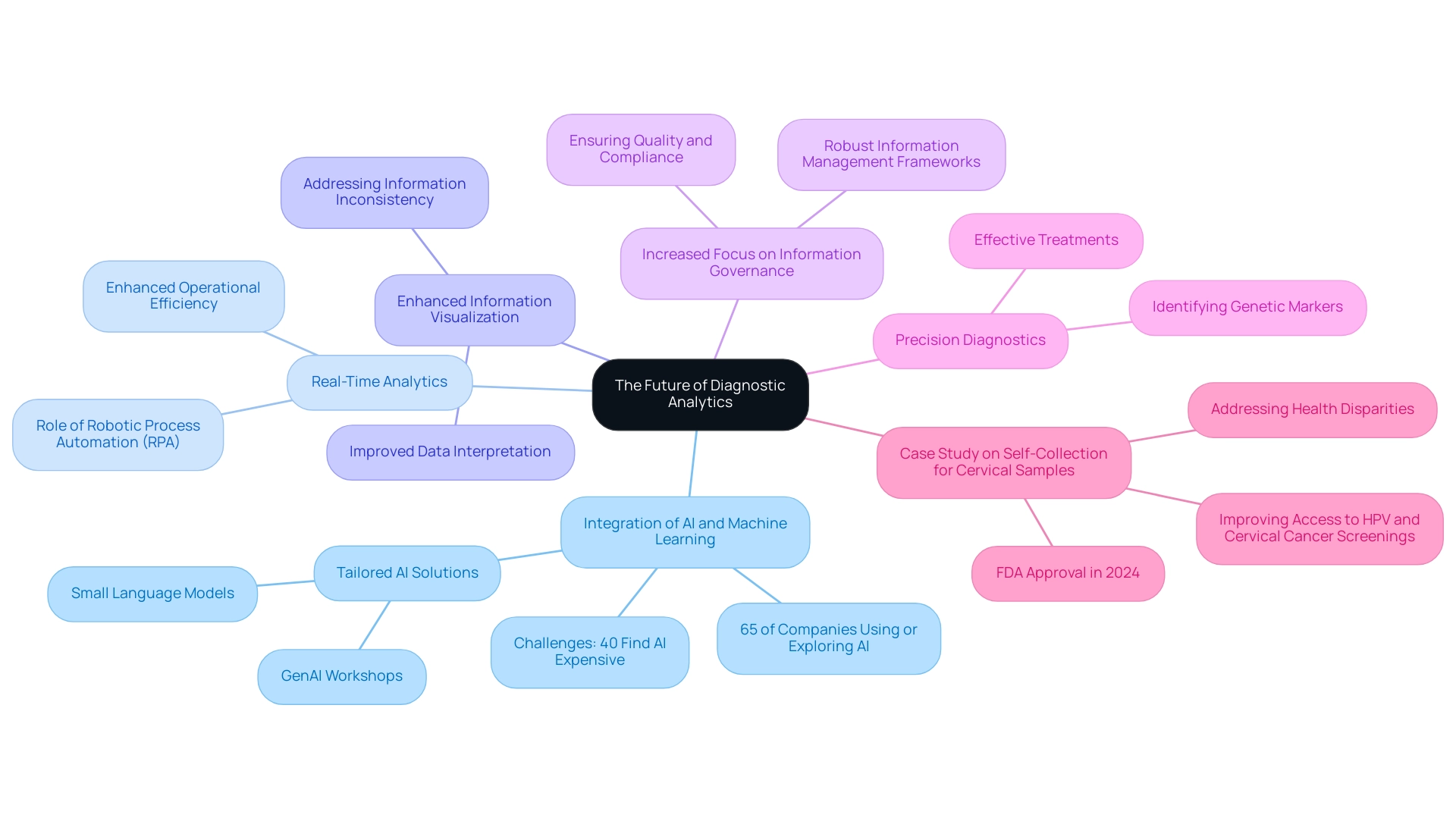
Conclusion
The exploration of diagnostic analytics underscores its significant influence on organizations aiming to boost operational efficiency and make informed decisions. By leveraging methodologies such as data mining, regression analysis, and anomaly detection, businesses can identify the root causes of their challenges, transforming raw data into actionable insights that propel performance improvements.
Numerous real-world applications across sectors like healthcare, manufacturing, and finance illustrate how diagnostic analytics empowers organizations to effectively tackle specific operational issues. Case studies reveal that harnessing these analytical techniques has led to marked enhancements in patient outcomes, minimized production delays, and optimized inventory management, showcasing the versatility and necessity of diagnostic analytics in today’s competitive landscape.
However, organizations must navigate obstacles such as data quality, implementation complexity, and resistance to change. By prioritizing robust data management practices and investing in user-friendly tools, businesses can surmount these challenges and fully leverage the power of diagnostic analytics. As the field evolves with advancements in AI, machine learning, and real-time analytics, those who embrace these innovations will be better positioned to drive growth and sustain a competitive advantage.
Ultimately, the effective utilization of diagnostic analytics transcends mere technical execution; it represents a strategic imperative that can profoundly affect an organization’s success. By cultivating a culture of data-driven decision-making and continuous improvement, businesses can unlock the full potential of their data, paving the way for sustained innovation and operational excellence.
Frequently Asked Questions
What is data analytics?
Data analytics is the systematic computational analysis of information aimed at uncovering patterns, correlations, and actionable insights to inform decision-making and improve operational efficiency.
What are the four primary types of data analytics?
The four primary types of data analytics are: Descriptive Analytics, which summarizes historical data to understand past events and identify trends; Diagnostic Analytics, which explains why certain events occurred by identifying relationships and root causes using techniques like information mining; Predictive Analytics, which uses statistical models and machine learning to forecast future outcomes based on historical data; and Prescriptive Analysis, which suggests actions to achieve desired outcomes by combining insights from predictive analysis with optimization techniques.
What percentage of information leaders monitor ROI from information analysis initiatives?
Only 33% of information leaders actively monitor their teams’ return on investment (ROI) from information analysis initiatives.
How have Robotic Process Automation (RPA) solutions impacted operational efficiency?
RPA solutions like EMMA RPA and Microsoft Power Automate have significantly improved operational efficiency by automating repetitive tasks and streamlining workflows, allowing organizations to focus on strategic initiatives.
What are some benefits of automating manual processes with data analytics?
Automating manual processes with data analytics can lead to considerable time savings, enhanced ROI, and improved employee morale as teams can concentrate on more strategic tasks.
How is diagnostic analysis defined and what questions does it address?
Diagnostic analysis is a subset of information examination that uses data to identify root causes of specific events or outcomes, addressing critical questions such as ‘Why did this happen?’
What methods are essential in analytical diagnosis?
Essential methods in analytical diagnosis include information mining, correlation examination, and regression analysis.
How is the use of diagnostic analysis expected to evolve by 2025?
The prevalence of diagnostic analysis is expected to rise, with organizations increasingly recognizing its value in improving performance and efficiency through AI-driven assessment tools.
Can you provide an example of how analytical evaluation has practical applications?
One example is in healthcare, where analyzing patient data can lead to personalized care strategies, such as adjusting dietary recommendations based on detected blood sugar spikes.
What role does regression analysis play in diagnostic analytics?
Regression analysis helps gain insights into the relationships within data, enhancing the reliability of findings and aiding in identifying root causes of problems.

